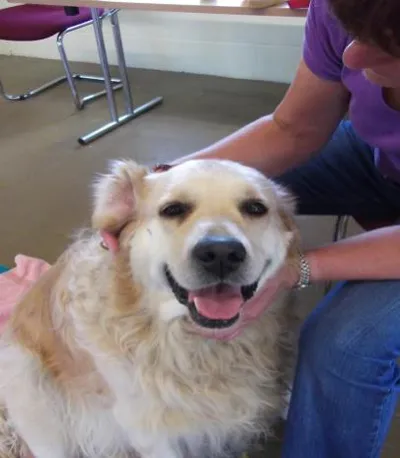
Healing works brilliantly on animals who tend to really enjoy the experience. All our Healers can work on Animals, some having chosen to specialise in this area.
Vet Richard Allport MRCVS writes :
‘In a sense Healing is the purest form of treatment for illness as it involves no pills needles or equipment of any kind. The laying on of hands to heal disease is of ancient origin and in all societies and cultures, people with healing powers are acknowledged’ ‘Most reputable healers in the UK belong to the NFSH ( now called the Healing Trust) which operates in a strictly ethical and professional manner.’ [They] have a code of conduct specifically regarding the treatment of animals, drawn up in conjunction with the Royal College of Veterinary Surgeons, to which they adhere’
Richard Allport B.Vet Med Vet MF Hom. MRCVS

Animal healing has been practiced in the Trust since the 1950’s when the famous healer Harry Edwards, our first president, ran Saturday sessions in the yard at Burrows Lea for local animals and there are still animal healing courses run there today. In those days Harry Edwards was so famous he was demonstrating healing to packed audiences in sell out displays at the Royal Festival Hall.


Research in healing has recently focussed on hormonal changes in Labrador dogs.

Japanese scientist Nagasawa (2009) showed the beneficial effects on human health of stroking a pet. His colleague Mitsui (2011) demonstrated the release of oxytocin hormone in dogs when hands on therapies such as massage and energy healing were given to dogs. The hormones excreted in urine, peak after an hour, as the system has been flooded with them up to that time. The physical signals of soft body posture, dilated pupils and male dogs exposing themselves, are all familiar signs during healing sessions. Oxytocin increases trust and socialisation which brings about important behavioural changes in dogs and their humans.
Andics et al in the Family Dog Project at the Hungarian Institute of Science (2016) used MRI scans with trained Labradors and collies, to monitor brain changes in real time. They found emotional responses from dogs to pictures, confirmed them as sentient beings. Follow up studies found dogs had a greater understanding of human speech than previously realised, using similar mechanisms of analysing words and tone used by humans. Their proven intelligence may explain greater willingness for dogs to co-operate in healing sessions, as they recognise it is intended to help them. They quickly learn that healing is an enjoyable and comforting sensation.
Many chronic conditions do not respond particularly well to conventional drug treatments with side effects or pain control becoming an issue with long term use. Canine arthritis is the most frequent reason given for elective euthanasia in the UK.

In 2013 in the US, Selby et Smith-Osborne completed a meta analysis of 103 web published studies of various complementary therapies with horses. They found an 11% improvement in chronic conditions, compared with only 1% spontaneous recovery.
They summarised that whilst further studies were needed ‘the evidence is promising in support of the effectiveness of complementary and adjunct interventions employing equines in the treatment of health challenges.’
Research has been conducted by Lisa Benn, a UK based healer and animal behaviourist, for her Master’s thesis, to see if healing could reduce stress levels in cats at an RSPCA rescue centre.

Chronic stress experienced by cats in rescue centres poses a significant challenge to welfare and re-homing potential. Results of the study showed a highly significant reduction in stress levels immediately following healing that was still evident 2½ hours later. It was concluded that healing could be a highly effective intervention to reduce stress and thus improve welfare and re-homing potential in kennelled cats.


Healing has been demonstrated in studies to :
In fact, animals are observed to respond more readily to healing and are more accepting than humans. Dogs also have heightened senses to objects approaching and are more aware of their energy fields. As pack animals, awareness of a calm environment is a well tuned survival mechanism, equating it with safety and relaxation time. Animals are often seen chewing or mouthing during healing, along with digestive rumblings as the sympathetic nervous system relaxes.
Animals cannot sign consent form or discuss symptoms, so it is required under sections 4.12-4.16 of the Healing Trust Code of Conduct to refer any medical conditions suspected or seen, to a registered veterinary surgeon. If the animal is already undergoing treatment, the healer must check with the vet that there are no contra-indications to giving healing therapy. Healers may not diagnose conditions nor introduce any non prescription, or herbal substances to an animal other than their own, unless qualified or authorised to do so.
Experience has shown that the following conditions are particularly likely to respond well to healing.
Chronic conditions are not always suitable for long term pharmaceutical solutions.The benefit of healing is that here are no known adverse side effects. The therapy is highly acceptable to animals and clearly enjoyable.

Rowland is pictured here having his first healing session with healer Lucy Lofting. He presented as a stressed, reactive, touch-averse dog in kennels, with an allergic itchy skin condition. He clearly found healing deeply relaxing and comforting within minutes.
Healing is not an alternative to or substitute for veterinary care and the Trust prefers the term complementary or integrated care, working with the veterinary professionals.

Elizabeth Whiter, founder of Healing Animals Organisation seen here discussing a patient with the Vet.
Quality assurance
Healer Members entitled to use the initials MNFSH after their name, will have undergone a thorough training to between two and four of the recognised levels, and had 2 years supervised practice before taking a final exam. In the Trust today, Healers are now required to be supervised for the first 200 hours of Healing practice after training.
All Healers are bound by a Code of Conduct, the animal sections were created jointly with the Royal Veterinary College; they carry insurance and are subject to a formal disciplinary process. They should be able to provide on request, evidence of cross training to animal healing work, appropriate knowledge of handling the species and two references, validating effective case work.


Taffy (pictured here with healer Lisa Benn) was a highly traumatised pony, terrified of people and would panic if anyone approached.
‘When he felt the healing he came over to me, pressed his head into my hands, took my finger gently in his lips, closed his eyes and remained there for over 20 minutes. With a combination of healing and behaviour modification he overcame his fears and his true happy and inquisitive personality shone through.’


‘Since I wrote the world’s first books on the topic of healing energy for horses( 2000 ) and pets ( 2002), the benefits of this therapy for animals has become globally known and acclaimed.
I have had huge success in helping a wide variety of animals with healing energy, and the humans who attend with their animals find that it helps them too. Animals, like us, are spiritual soul beings, and they naturally understand healing energy. They are attracted to healers because through practising healing energy we emanate inner stillness. Healing for animals is something that anyone can do with a bit of knowhow.
As well as helping animals, it strengthens the bond between us.’
Margrit Coates MNFSH SBRCP ITEC

‘The benefits of healing to help physical problems are well documented.
However I also find healing invaluable in my work as an animal behaviourist.
Many behaviour problems result from pain, anxiety, fear, frustration or confusion. After physical pain has been ruled out, healing can play a vital role in the animal’s rehabilitation by reducing stress, building trust and confidence and helping them understand what we are asking of them.
I can’t imagine doing my behaviour work without healing as it is such a powerful means of communication. It is wonderful to help animals in this way.’
Lisa Benn MSc CABC, MNFSH

‘Healing takes me all over the world to help animals in need. Healing supports all animals at every stage of their rehabilitation. Healing is a natural therapy promoting calm, peace and deep relaxation; a perfect complement to veterinary care.
I work with and train vets from Europe to Tokyo to South Africa and Egypt in energy healing. Together we are a winning team for the highest good of all animals. Below is one example of our healing work.’
Elizabeth Whiter MHAO MNFSH IIZ ITEC Dip.WSA

‘My previous healing work for 15 years with human cancer patients, led me to wonder what I might do for animals. Having introduced healing to an NHS hospice with a study in 2001, I was able to gain credibility with a leading dog re-homing charity and now give around 300 healing
treatments a year to dogs at their London re-homing centre. I find healing particularly helps anxious and reactive dogs to relax in care.
They are seen to trust both people and other dogs more readily after therapy, probably due to an oxytocin response. I’m sure this improves their re-homing chances. I find animals take to Healing even more readily than humans do.’
Lucy Lofting BSc M Phil MNFSH
The Healing Trust’s ‘Charity Champion for Animals’

Healing is used by a number of animal rescue charities and horse sanctuaries in the UK to improve quality of life. The last word on integrated care in practice has to go to a multi species rescue charity who use healing led by Elizabeth Whiter:
Animal Care Egypt are hosts to Elizabeth and her healing students every year. We see the positive benefits of the relaxation techniques offered to our inpatients/outpatients of donkeys, horses, cats and dogs at the animal hospital. The healers work quietly, professionally and methodically alongside our vets.
Energy healing is the forefront of their work, which also includes a healing clinic for our veterinarians with relaxation sessions to help cope with the stress and strain from the highly physical and mental work that they do with animals every day. We are very happy and privileged that they help us in Luxor and we look forward to their next visit
Kim Taylor Founder and Principal Animal Care Egypt.
Finally for reference, the British Small Animal Veterinary Association (BSAVA ) guidance on choosing an animal healer.